08. Prey Guide
03-10-2015, 05:03 PM
(This post was last modified: 07-16-2019, 04:21 PM by Nyx.)
BOREAS
LARGE PREY
LARGE PREY
Rarity goes as follows: Common, moderate, uncommon, rare.
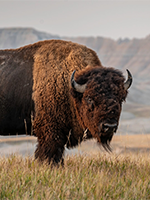 |
Bison Description: Bison are one of the largest bovine ungulates in the world. They are huge, shaggy beasts with a hump over their shoulders and massive heads. Both sexes bear short, curved horns. Heights range from about 60 to 73 in (152 to 186 cm) at the shoulder, and weights from 701 to 2,000 lb (318 to 907 kg) with the heaviest weighing in at around 2,800 lb (1,270 kg). Cows give birth to a single calf in the late spring. Habitat: Bison prefer river valleys, plains, and prairies, though they may be occasionally found in lightly wooded areas. They can also be found in hilly or mountainous regions where the slope is not steep. Behavior: Bison travel in generally same-sex herds except during the summer rut, when the bulls vie for harems of cows. Bison tend to have five defensive behaviors to protect calves from wolves - running to a cow, running to a herd, running to the nearest bull, running in the center or front of a stampeding herd, or entering a body of water. When fleeing wolves in an open area, cows and calves tend to take the lead, while bulls follow behind in order to protect them. Location: Rarity: uncommon |
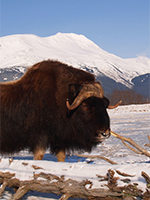 |
Musk ox Description: Large, shaggy ungulates. Both bulls and cows sport large, curving horns. They range in height from 4 to 5 ft (1.1 to 1.5m) high at the shoulder and weigh from 400 to 900 lbs (180 to 410 kg) with an average weight of around 630 lbs (285 kg). The guard hairs in their shaggy coats can often reach nearly to the ground and is prized for its soft and insulative values. Males emit a strongly musky scent during rut, for which they are named. Habitat: Animals of the tundra, in the winter they migrate to higher altitudes where the snow is thinner, but in the summer prefer wet areas such as river valleys. Behavior: Musk ox herds (ranging from approximately 12-24 individuals in the winter or 8-20 in the summer) have a very distinctive method of defense, that of forming a stationary ring facing outward around the young of the herd. This allows them to bring their large horns into play. During the summer rut the subordinate and juvenile males leave the herd to form bachelor groups, but when in danger are allowed back into the herds for protection. When they do run they can reach speeds of up to 37 mph (60 km/h). Cows will give birth to a single calf in the late spring or early summer. Location: Rarity: rare |
 |
Moose (Eurasian Elk) Description: The largest species of deer in the world, moose are distinguished by the bulls’ unique antlers, which are palmate (broad and flattened) rather than dendritic (twig-like) like other deer. They range in weight from 840 to 1,540 lb (380 to 700 kg) for bulls and 440 to 1,080 lb (200 to 490 kg ) for females. The average adult stands approximately 4.6–6.9 ft (1.4–2.1 m) at the shoulder. The distinctive upper lip is very sensitive and is prehensile to assist in grasping their food. Habitat: Moose can be found in forests ranging from temperate to subarctic areas. During the summer they prefer areas with rivers or marshes and are great swimmers. Behavior: Moose are solitary creatures and don’t form protective herds. Although moose often flee when faced with danger they can sometimes be extremely aggressive towards predators, particularly males during the fall rut or females with calves. If annoyed or frightened they may charge. They have been known to stomp wolves, and can kick out with both fore and hind legs in any direction (including sideways, unlike most other ungulates). They have even been known to fend off attacks from bears. The nose is very sensitive, and a bite there may immobilize a moose. Cows give birth to one or two calves in early summer. Location: Rarity: moderate |
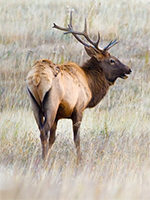 |
Elk (Wapiti) Description: One of the largest deer species in the world. Cows range from approximately 500 to 550 lbs (227 to 250 kg) and stand about 4.3 ft (1.3 m) at the shoulder, with bulls about 40% larger, and can reach up to 1200 lbs in some subspecies. They are a reddish brown hue with a buff colored rump, with calves being born spotted. Males carry large antlers which they shed in the winter after rut. Habitat: Mostly forested areas and the edges of forested areas. Tend to migrate to lower elevations in the fall to follow the snow and retreat to higher elevations in the spring. Behavior: Defensive behaviors include banding together in large, single-sex herds for greater safety. Though males are less likely to join together while they have antlers, once they are shed they form bachelor herds for protection. Healthy animals will generally stand their ground at an attack, striking out with their front legs or antlers to fend off attackers if posturing and threatening sounds don’t scare them away. Cows give birth to a single calf in late spring or early summer. Location: Rarity: moderate |
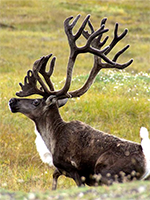 |
Caribou (reindeer) Description: Caribou are a large species of northern deer. They are uniquely adapted to the cold, having hollow-hair fur that covers nearly all of it’s body - including it’s nose - to provide winter insulation and floatation when swimming. Both sexes bear antlers, though cows’ are smaller. Their legs make a unique clicking sound when they walk, considered to be the sound of their tendons sliding over the sesamoid bones in their feet, and can be heard from a good distance away. Heights on average range from 34–62 in (87–158 cm) at the shoulder for males and 31–55 in (80–139 cm) for females. Weights average 146–661 lb (66–300 kg) for males with the largest at 680 lb (310 kg), and 112–344 lb (51–156 kg) for females. Cows give birth to a single calf in the late spring. Habitat: Caribou are highly migratory tundra animals, with most subspecies preferring open grazing lands where they feast primarily on lichens, while some subspecies prefer mature woodlands where arboreal lichens grow. Behavior: Caribou travel in large herds and travel up to 3,100 mi (5,000 km) in a year migrating from their winter feeding grounds to their calving grounds and back. They break apart into smaller herds during their fall rut to mate, but join back together to continue their migrations. They can run up to 37–50 mph (60–80 km/h) and swim up to 6.2 mph (10 km/h) and will not hesitate to jump into lakes or rivers to escape pursuit. Location: Rarity: common |
 |
Desert bighorn sheep Description: Desert Bighorns are big, stocky sheep that have adapted themselves to desert conditions and can go longer periods without water. Rams and ewes both begin to grow horns shortly after birth and though ewes have smaller, lighter horns with less curvature, rams sport large, curling horns that continue to grow their whole lives. Adult rams range in weight from 115 to 280 pounds (55 to 90 kg), with ewes a bit smaller. The height tends to be around 32-40 “ (81.3 - 101.6 cm) at the shoulder. Desert bighorn give birth to one lamb (rarely twins) at any time of year but usually late winter or early spring. Habitat: As the name implies, these sheep inhabit barren desert regions. They prefer regions with steep, rocky slopes. Behavior: During times of wet weather when the usually sparse grass is lush, these sheep are able to derive almost all their water needs from the grass. Even during the harsh summer, most healthy sheep need only venture out to drink once every three days, though lactating ewes need to drink nearly every day. This is the most dangerous time for them if they must venture too far from their rocky homes, since their greatest defense lies in their uncanny ability to race up cliff faces with ease, leaping from tiny ledge to tiny ledge over distances as great as twenty feet. They can move up to 30 mph on flat land, and up to 15 mph on mountain slopes. Location: West (Whisperer’s Gorge, Redwater Rocks, Palmetto Wash, Deadman’s Scrap, Crier’s Ravine) South (Barren Hills) Rarity: moderate |
 |
Dall Sheep Description: A northern species of sheep, Dall sheep are generally white though range in color to a slate brown in color. Both genders have horns, but the ewes have smaller, more slender horns that curve slightly while the males have heavy, thick and curling horns. The average height at the shoulder is 37”, while weight ranges from 100-110 pounds (46-50 kg) for ewes and 160-200 pounds (73-90 kg) for rams, with some rams weighing more than 250 lbs (113.4 kg). Ewes give birth to one lamb in the early summer. Habitat: This northern species has a preference for relatively dry, cold places with steep ridgelines and rugged terrain. Behavior: Adult rams tend to travel in groups and only rarely interact with ewe groups, usually during the late fall rut or at mineral licks. When in danger they flee to steep, rocky outcroppings to escape their attackers. Lambs are most vulnerable within the first few weeks of life. Location: North (polar sound, waterfall peak, gale gorge, dreamer's col, outside of: lifeless caverns, caves of the past, northern mines) East (Fenrir's Maw, Chrystallum Cliffs, Moontouched Cliffs, outside of: styllanos crypt, singing caverns) Rarity: moderate |
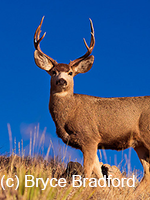 |
Mule Deer Description: Mule deer are named for the distinctively large ears it bears, a desert adaptation where the large ears provide greater surface area for cooling the deer. Unlike their close cousin the whitetail, mule deer sport antlers that branch out into two equal forks rather than many small tines. Large hooves allow them another advantage in the desert, as they can claw out water as deep as two feet down. Does give birth to 1-4 fawns in early summer. Habitat: This deer species is found primarily in desert regions, being well adapted to the heat, and generally seek out arid, rocky homes with wide open areas. Behavior: During the fall rut large groups of mule deer travel together, the males vying for and rounding up females to mate with. After the rut the groups remain together until spring - when antlers start to regrow and fawns are being born, the groups break apart. Does nurse their young solitary, while bucks may continue to live in bachelor herds. When startled, Mule deer move in stiff-legged jumps with all four feet hitting the ground together, called stolting, which allows them to outrun predators in the uneven terrain they reside on, as well as seeing over tall brush. They can turn or reverse directions in a single bound, and will occasionally stop to look behind them to see if they are still pursued. They do not flag their tails when startled. Location: arid desert lands and grasslands, never tundra and very rarely woodlands Rarity: common |
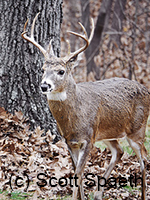 |
Whitetail Deer Description: The white-tail deer is a largely boreal species of medium size deer. Their name is derived from the fact that the underside of their tail is a bright white to better stand out against the brown of their coat when they raise it in alarm. Antlers are typically symmetrical, with the points all growing straight up off the main beam, but atypical spreads sometimes may be asymmetrical and grow at any angle. Bucks weigh in on average from 130 to 290 lb (130 to 290 lb) and in rare cases over 350 pounds, and does at 88 to 198 lb (40 to 90 kg), with the larger of the species typically found in the northern reaches of their range and the smaller the further south they are. Does give birth to 1-3 spotted fawns in mid to late spring. Habitat: Whitetail are generally found in and around temperate forested areas, rarely grasslands and never desert lands. Behavior: Whitetail bucks during their fall rut are considerably less wary than at any time of the year, their preoccupation with breeding such that they often even forgo eating and drinking and lose body condition. In the spring, the young fawns are left hidden alone while the mother ventures out for food, dependent on their spots and lack of scent to conceal them. When frightened, deer will blow (snort air loudly out their nose) and run in a zig-zag pattern with their tails up in warning, but when they feel especially threatened or their fawn is endangered they may charge, using their sharp hooves and their antlers - or for does and unantlered males, just their head - to ward off a predator. They can run up to 47 mph (75 km/h) in a sprint and jump up to 8.9 ft (2.7 m) and up to 33 ft (10 m) long. Location: most lands except deserts, very rarely in tundra and prairie lands Rarity: common |
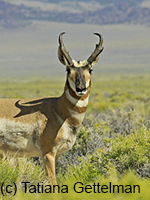 |
Pronghorn Description: The pronghorn, though it is unrelated to antelope, greatly resemble them. They are grassland grazers with both sexes having flattened, branching “horns” of bone that give them their name, though the does’ are much smaller and rarely pronged. They have distinctive white patches on their rumps, sides, chests, bellies, and across their throats, with males also having a black patch across their throat. They have a very distinctive musky odor. Does give birth to 1-2 fawns in late spring. Habitat: Pronghorns prefer open grasslands and desert lands where they can take advantage of their speed to outdistance predators. Behavior: The pronghorn is the second fastest land mammal in the world, second only to the cheetah and able to run 35 mph for 4 mi (56 km/h for 6 km), 42 mph for 1 mi (67 km/h for 1.6 km), and 55 mph for 0.5 mi (88.5 km/h for .8 km). In the winter they form mixed-sex herds, but in the spring the herds break apart; young males form bachelor groups and females form their groups, while adult males live solitarily. Fawns are generally left hidden alone for the first month before joining the female groups’ “nursery”. Location: desert lands and grasslands, never tundra or woodlands Rarity: uncommon |
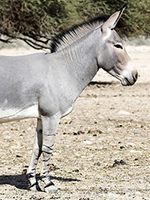 |
Wild Asses Description: Believed to be the ancestors of domesticated donkeys, wild asses are desert-dwelling equines. They stand around 51 to 59 in (1.25 to 1.45 m) tall and weigh between 510–610 lb (230–275 kg). Their smooth hair ranges from a gray to a fawn color, with all subspecies carrying a dark dorsal stripe - some also carry a stripe across the shoulders, while others bear striped legs. They have short, stiff manes and their tails end in stiff hairs as well. Their hooves are solid like horses, and their ears are large and rimmed in black. They are well suited to lands with little, and low-quality foods. They usually give birth to a single foal in the winter rainy season. Habitat: Scrub lands and deserts are the wild ass’ preferred homelands Behavior: Active mainly during the cooler parts of the day in the morning and evening and resting during the hot midday period, they live in loose herds of up to fifty asses. These herds are often spread out over a very wide range due to the sparsity of the vegetation they feed on. Asses can run quite swiftly and are sure-footed and agile, but unlike most prey animals their first instinct isn’t to run, it’s to go investigate… and these equines are very capable of defending themselves if need be, able to kick with both front and back legs and often employing their wide, flat teeth as well. Location: desert lands Rarity: rare |
BOREAS
SMALL PREY
SMALL PREY
Rarity goes as follows: Common, moderate, uncommon, rare.
 |
Northern Porcupine Description: Northern porcupines are larger than the southern species at 2-3’ (60-90cm) not counting the tail, and weighing from 7.7-39.7lbs (3.5-18kg) with an average of 20lbs (9kg). Next to the beaver, they are the second largest rodent on the northern continent. They are heavily built, with a small face, a short thick tail, and short legs. They are dark brown or black with white highlights, and their wooly fur and long guardhairs are interspersed with hollow, barbed quills everywhere but their underbelly, face, and feet. These quills actually have an antibiotic coating in case the porcupine accidentally quills itself, which can happen if the porcupine falls out of a tree as they tend to do. Porcupines also produce a foul odor when threatened. Near the beginning of the summer, these unusual rodents give birth to a single offspring called a porcupette. Habitat: Northern porcupines live in forests, or occasionally in scrubby areas Behavior: Porcupines are nocturnal creatures, sleeping during the day in either trees (in the summer) or dens in the winter. They don’t have a winter hibernation, but they tend to stay near their dens at that time. They are solitary animals, except mothers with young porcupettes. They spend much of their time in trees as that is where their food supply is found. Slow moving and nearsighted, a porcupine is not built for running away. Unfortunately for any hunter, they have their defenses built in. They’ll give warnings, including releasing a foul odor, clacking its teeth, and bristling its quills to display a distinct white warning stripe to seek to dissuade a hunter. If that fails to stop an attack, the porcupine will turn it’s back to the predator and attempt to strike the attacker with its quilled tail in the hopes of embedding quills in the predator’s face. Failing in that, the porcupine may attempt to climb a tree to escape. Location: Rarity: common |
BOREAS
WATERFOWL AND GAMEBIRDS
WATERFOWL AND GAMEBIRDS
Rarity goes as follows: Common, moderate, uncommon, rare.
 |
Ducks Description: Ducks are a group of aquatic birds inhabiting both fresh- and salt-water areas. They are generally long-bodied and broad, and relatively long necked though not to the extent that their cousins the geese and swans are. They have webbed feet and waterproof feathers to allow them to spend their time in water without getting soaked. Their wings are typically short and pointed, and quite strong due to the way ducks fly. They are in general much smaller than geese and swans. Typically, northern species will display a strong sexual dimorphism in their plumage, with adult males having more extravagant plumage to attract mates, while the young resemble the female in appearance. Most duck species nest near water in either spring and summer, or the wet seasons depending on their locations, and will lead the ducklings to water after hatching. Habitat: wide variety - mostly near water and on islands Behavior: Many northern duck species are migratory, but southern ducks usually are not, and ducks in areas without a lot of water tend to be nomadic and seek out water as it gathers after rains. They tend to spend a lot of their time in and around water sources seeking food, but they nest on land and many species will also forage along shorelines. Ducks will attempt to escape predators by either seeking out water to swim away from land based predators, or flying away. Once in flight they are fast and generally safe from most predators except birds of prey, but it can often take a bit of time to get completely off the ground. Ducklings are far more vulnerable to predators, being unable to fly, and brooding females can be caught on their nest by land-based predators. Location: watery areas and islands on both continents Rarity: common |
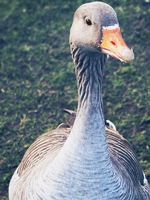 |
Geese Description: Geese are a group of large waterfowl arrayed in size generally between ducks and swans. They tend to have more webbing on their feet than their smaller duck counterparts, longer wings, and more elongated necks. Though they too are aquatic birds and live around and on bodies of water, they spend more of their time on land as they have a diet consisting more of leafy greens and grains rather than fish and insects. Depending on the species, geese may lay between two and nine eggs that will hatch out into goslings. Habitat: wide-open areas near water Behavior: Geese tend to flock together during the migratory season, traveling long distances together. Geese are generally monogamous, and during mating and brooding season will stake a claim on a territory and defend it, though outside of those times they are not usually territorial. They nest on land, in a large open cup in an elevated area near water, so they may have a relatively good view in several directions. The female will do all the incubation while her mate guards her and their nest. Both male and female are very aggressive in the defense of their nest and later, their goslings. They usually remain close to water to allow goslings a chance to escape predators by taking to the water, and prefer wide open areas where they may see predators coming. Adult geese without young will generally take to the air to escape predators that they cannot frighten away or fight off. Location: north and south continent Rarity: common |
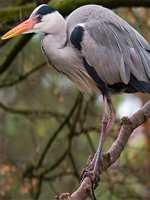 |
Herons Description: Herons are generally medium to large sized non-swimming water birds with long legs and long necks. Their necks are able to be retracted or extended due to the unusual shape of one of the vertebrae. Unlike other long necked birds herons retract their necks in flight. The bill is typically long and thin in the manner of a harpoon to assist in their carnivorous diet. Herons usually lay between three and seven eggs depending on the species. Habitat: lands near water Behavior: Herons are typically monogamous and congregate in colonies for migration. They hunt alongside water, generally wading out and standing still or moving very slowly to ambush their aquatic prey. This activity most often, though not always, takes place around twilight times or at night to avoid competition. Nesting is mostly in colonies, with the nests usually found in vegetation near or above water, though some species nest on the ground in areas where trees and shrubs aren’t available. They can be a danger to predators if not taken by surprise, using their wickedly sharp beak to stab at the enemy. They will also often take cover in trees to escape. Location: north and south continent Rarity: moderate |
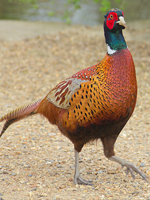 |
Pheasants Description: Habitat: Behavior: Location: Rarity: moderate |
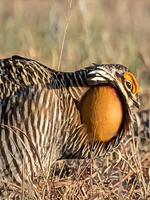 |
Prairie Chicken Description: Prairie chickens are, as the name suggests, a chicken-like bird. They are medium to large, with a stocky body and round wings. Adult males possess orange, comb-like feathers over their eyes, and a circular, orange featherless patch on their neck that is inflated while displaying. They also have dark, long head feathers that can be raised. Females have shorter head feathers and lack both the featherless patch and the comb feathers. Hens will usually lay between 5 and 17 eggs per clutch in the spring. Habitat: Prairie chickens prefer undisturbed prairie, particularly prairies with tall grasses, or forested grasslands Behavior: Prairie chickens are non-migratory, and males will defend a territory, called “booming grounds” that they use to perform displays to attract females. The young are raised solely by the females. During the winter when the snow is thick prairie chickens will often burrow in the snow to keep warm. They seek to avoid predators by hiding in tall grasses. Location: grasslands or lightly forested lands Rarity: common |
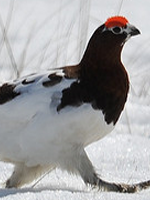 |
Ptarmigan Description: Ptarmigan are a northern family of birds, and with three separate species making up the family they are found in every land in the north from forests to tundras to mountains. They are a deep-chested, chunky bird with a fairly long neck, broad beak, and short feathered legs. All ptarmigan except a subspecies of willow ptarmigan, have white winter plumage to assist them in hiding in the snow. In the summer ptarmigan range from reddish to grayish brown. They often hatch around six chicks. Habitat: any northern regions, with various species filling different ecological niches Behavior: Ptarmigans are an herbivorous species, eating a wide range of plant matter, though as juveniles they will often feed on insects as well. They tend to be territorial birds during breeding and generally monogamous pairs are formed. They nest on the ground, usually in a hidden location near the edge of a clearing or sheltered area. If the nest is threatened, the pair will often divebomb the attacker, or attempt to lure them away by faking a broken wing. Adults generally depend on their camouflage to protect them from predators. During winter months, some species avoid flight as much as they can, roosting in snowbanks to conserve their energy and avoid predators. Others are often migratory, with females and offspring tending to migrate further than males. Although they spend much of their lives on the ground and usually walk or run from place to place, they are agile fliers and may take to the air to escape a predator. Location: All lands in the northern region of the northern continent Rarity: common |
 |
Ruffed Grouse Description: Ruffed grouse are sturdy, medium sized ground birds with short, strong wings. Typically grey or brown for camouflage, they have a ruff on the sides of the neck that give them their name. Additionally they have a crest on top of their head which can sometimes be laid flat. The males produce a rather distinctive drumming sound, caused by a rapid wing-beating display that creates a sound of such low frequency that it is almost felt rather than heard. The hens generally lay a clutch of about 9-12 eggs a year. Habitat: woodlands, typically in areas that receive snow in the winte Behavior: Ruffed grouse spend most of their time on the ground, bobbing through thickets looking for food. They depend mainly on their excellent natural camouflage to protect them, but when surprised they may explode into short flights to escape. In the winter when they’re burrowed in the snow for warmth, they may suddenly burst out in flight when approached too closely by a predator. Location: Rarity: common |
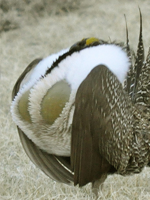 |
Sage Grouse Description: Sage grouse are large gamebirds with long, pointed tails and legs that are feathered down to the toes. Adult males are grayish brown on top with a dark brown throat, black belly and white breast. They have yellow patches over each eye, and two yellow sacs on the neck that are inflated during courtship displays. Adult females are grayish brown with a light brown throat and a dark belly. Typical clutch size is around six to eight eggs. Habitat: Sage grouse typically live in sagebrush-grassland or juniper sagebrush-grassland, often using meadows surrounded by sagebrush as feeding grounds. Behavior: Sage grouse are ground-nesting birds who prefer to hide their nests in tall, dense plant cover. Grouse without nests will usually use relatively open areas to feed, while roosting in dense patches of sagebrush. Though they are strong fliers, sage grouse prefer to walk. Since running is difficult with their short legs, they must escape predators by either hiding in dense foliage or flying away. Location: West: Sycari Strip, Palmetto Wash, Sand River, Traveler’s Lake, Redwater Rocks Rarity: moderate |
 |
Swans Description: Swans are large waterfowl, typically the largest in the family that includes ducks and geese, and are among the largest of all flying birds with the largest species able to reach a length of over 59” (1.5m), weigh in at over 33lbs (15kg) and have a wingspan of over 10’ (3.1m). Northern species have pure white feathers, while southern species are generally a mix of black and white. Adult swans have a distinctive patch of unfeathered skin between their eyes and their bill, and their beaks have serrated edges for catching their food. The number of eggs in a clutch, laid between spring and summer, typically ranges from three to eight. Habitat: lands near freshwater marshes, ponds, lakes, and slow flowing rivers Behavior: Many species are at least partially migratory so may not always be present in hunting lands. They feed in both water and on land, so are usually to be found near ready sources of water. They form monogamous pairs, even in species that tend to flock together during migration. The nest is located on land near water. Unlike in other waterfowl species, the male assists with both the nest construction and the incubation of the eggs. Both male and female swans are extremely aggressive in protecting their nests and their cygnets, and their large size often allows them to drive off predators by pecking at the enemy or beating them with their strong wings. Within a couple of days cygnets are able to swim and dive beneath the water to escape danger. Adult swans are often seen carrying their cygnets on their back while swimming. They do not begin learning to fly until around four months of age. Location: north and south continent Rarity: rare |
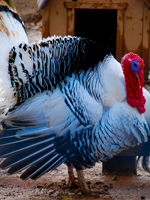 |
Northern Turkey Description: Northern turkeys are large, heavy set birds with long legs. Males have featherless red heads with a red throat and red wattles on their throat and neck as well as a fleshy snood over their beak. Adult males have long fan-shaped tails and a spur on the back of each leg. Females are smaller and have duller colors in addition to lacking wattles and snood. Both genders tend to be brown in coloration, with males displaying iridescence on their feathers while females are duller grays and browns. Hens lay a clutch of 10-14 eggs around the end of spring. Habitat: Turkeys prefer forests, and may be found in pastures, fields, orchards and marshes nearby to forests as long as plenty of coverage is available. Behavior: Despite their heavy bodies, turkeys are agile fliers and may often fly beneath the canopy to find perches. They usually fly close to the ground for short distances. They prefer to use the early morning and late afternoon for foraging. Nests are generally simple shallow dirt depressions in woody vegetation. When predators are spotted, turkeys and their poults prefer to run away rather than fly, though they may fly for short distances if pressed. Adult turkeys may try to fight off predators if they are unable to escape, particularly large male turkeys who may kick, using the spurs on their legs as weapons, bite with their beaks and even attempt to ram the predator using their large bodies. Location: forested areas and lands near forests in the northern continent Rarity: common |
04-19-2016, 06:41 PM
(This post was last modified: 07-16-2019, 04:24 PM by Nyx.)
AUSTER
LARGE PREY
LARGE PREY
Rarity goes as follows: Common, moderate, uncommon, rare.
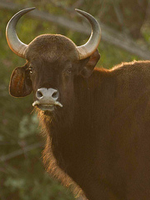 |
Gaur Description: A type of large wild-cattle, gaurs stand around 65 - 87 in (165 - 220cm) at the shoulder, and weigh around 1430 to 2200 lb (650 to 1000kg), though some may weigh more than that. They have medium-sized horns that are very sharp. Bulls are generally a dark brown to black color, with cows being several shades lighter - from a sandy brown to a medium brown. Cows give birth every other year, typically around September to March. Habitat: Evergreen or deciduous forests Behavior: Gaurs are diurnal and are most active during the peak daylight hours, with it being very rare to see one active at night. When threatened, they are very aggressive and bold, and a gaur will often call for help. Bulls and cows live separately, usually coming together only to breed. Cows can be in groups of more than 50 individuals, whereas bulls are much more likely to be solitary. Location: forested areas in the southern continent Rarity: uncommon |
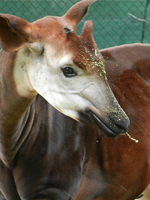 |
Okapi Description: Okapi are known for their stripes that are reminiscent of a zebra’s, though they are not related to zebras at all. They stand at 58 to 80 in at the shoulder, and weigh 440 to 720 lb. They are primarily chocolate brown to a reddish brown in color, with white stripes and bands going up their legs, with males also possessing very short, hair-covered horns. Females generally give birth to one calf, and will only breed about every other year. Offspring can be born at any time of the year. Habitat: canopy forests Behavior: Okapi are diurnal, being most active during the day but may also remain active for a few hours of the night. They are primarily solitary, meeting only when it is time for breeding. They do have overlapping home ranges, however, with male ranges being much larger than females. Males typically migrate while females do not. They are generally tranquil creatures, however when threatened, they can become aggressive and will kick or headbutt. Location: forested areas, never deserts or swamps Rarity: rare |
 |
Takin Description: The takin is an odd sort of creature that is often referred to as a ‘goat-antelope’ due to having characteristics of both species, though it is mostly closely related to sheep. They are stocky-bodied, with large heavy heads with a distinctive long, arched nose. The takin is very similar to the muskox in size, being 38 to 55 in (97 to 140cm) in height, and weigh around 570 - 770 lb (250 to 350kg). They vary widely in color, from a light cream to an almost black, though kids are darker and they tend to lighten as they age. All takin have a dark stripe on their back that makes it easy to distinguish them from other species. Both sexes have shiny black, crescent-shaped horns that grow from the center of their massive head and can reach up to 45” (90cm) in length. They have a strong, unique odor that smells something like a combination of horse and musk, and their skin secretes an oily, bitter-tasting substance that acts as a natural raincoat. In the early spring, a cow will give birth to a single kid or, rarely, twins. Within three days of birth, kids are able to follow their mothers through most types of terrain. Habitat: In the spring and summer, they migrate to rocky, grass covered areas at higher elevations, while in the fall and winter they congregate in forested areas where there is more food to be found. Behavior: Takin live in small groups of up to 20 individuals made up of both sexes, and oftentimes the offspring as well. However, it’s not uncommon for older males to strike out on their own. They are most active during early morning and late afternoon. During the spring and warm months, takins gather in large herds and migrate up to higher elevations, but as winter approaches they move back down to forested valleys. As they migrate across their range, they tend to use the same routes over and over, creating well-worn paths through the dense areas of bamboo and underbrush. When feeling threatened, takin will often flee and lay down into bamboo to disguise themselves, and they are quite nimble at leaping from rock to rock; however, if a hunter is able to corner one at a salt lick (which they frequent regularly) then it is quite easy to kill one - though you have to contend with the horns. Location: rocky areas and forested areas Rarity: uncommon |
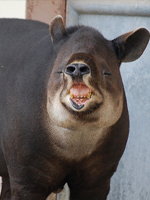 |
Tapir Description: Tapirs are medium-sized herbivores that are similar in appearance to pigs, but with a short, prehensile snout. They stand around 3’ (1m) high at the shoulder and weight 330-700lbs (150-300kg). They have short coats that range in color from grey to reddish-brown to nearly black, with babies having striped and spotted patterns for camouflage, and have thick skin on the backs of their necks to help ward off predators. Females give birth to a single calf every two years. Habitat: forest regions, often with close access to water Behavior: Tapirs are mostly nocturnal and crepuscular (active during twilight). Other than mothers and offspring, tapirs are almost exclusively solitary. When located near water, they spend a lot of their time in and under the water to feed and hide from predators, often sinking to the bottom to walk along the riverbed. Additionally they often wallow in mud pits to stay cool. When on land, they spend a lot of their waking hours seeking food along established trails. Tapirs are fairly fast despite their appearance, and when threatened will seek shelter in thick undergrowth or water. Location: forests, rivers or ponds near forests Rarity: common |
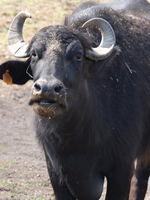 |
Water Buffalo Description: Wild water buffalo strongly resemble their domesticated descendants, though there are many differences both physically and temperamentally. They stand much larger than the domesticated breed at 59 to 75 in (150 to 190 cm) and weigh anywhere from 1,500 to 2,600 lb (700 to 1200 kg). They range from ash grey to black in color, and their hair is long and coarse. They have very large and wide horns that extend up to 79 in (2m) that can pose quite the danger while hunting them. As their name might suggest, they prefer living in more wet areas. They typically give birth every other year around the summer. Habitat: wet grasslands, swamps, densely vegetated river valleys Behavior: Water buffalo can be active during the day or at night, though they are the most active during the late afternoon and early evening. They lives in clans that can contain up to 30 buffalo, and are led generally by the older females. There may also be bachelor groups of up to ten males. Cows are very protective of their young, and will form protective lines around the calves until the thread is gone. If the threat persists, they will break off and run into the nearest vegetation. Location: wetlands Rarity: uncommon |
AUSTER
SMALL PREY
SMALL PREY
Rarity goes as follows: Common, moderate, uncommon, rare.
 |
Dik-dik Description: The dik-dik is a small antelope measuring 12-16” (30-40cm) at shoulder and weighing 7-16lbs (3-6kg) with females generally being slightly larger than the males. Males have small (approximately 3”) horns. The upper parts of their body are a grayish brown, while the lower parts including the underbelly and legs tend to be a tan color. A black spot beneath each eye contains scent glands that they use to mark their territories. They tend to give birth to a single offspring twice a year - once at the beginning of the rainy season and once at the end. Habitat: As they prefer foliage, shoots, fruits and berries rather than grass, dik-diks generally inhabit areas with large amounts of scrubland, occasionally dense woodlands and other places with plenty of cover and not very much tall grass. Behavior: Dik-diks usually live in pairs in established territories. Males mark the territories with distinctive piles of dung. These territories have plenty of cover and are usually in places with a lot of low shrubby bushes, or sometimes along dry streambeds. Their territories will have established paths through and around the borders of their territories for them to run quickly along when they are threatened. Dik-diks have excellent eyesight and are fast for their size, able to reach speeds around 26 mph. Location: shrubby areas and dense forests Rarity: moderate |
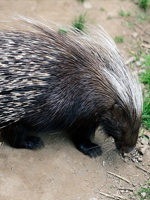 |
Southern Porcupine Description: The southern porcupine is a large arboreal rodent weighing around 9lbs and reaching lengths around 40”, though approximately half of that length is made up of their tail. Like their northern cousins, southern porcupines are covered in barbed quills interspersed among their fur. They are smaller than northern porcupines, and have a long, spineless prehensile tail that curves upward at the end to more easily grip tree branches. Their front and back paws are modified for grasping, these two adaptations making them quite adept at climbing. They tend to give birth to a single porcupette in the spring, with newborns covered in hair and soft quills that will begin to harden after birth. Habitat: They inhabit southern forests with plenty of trees. Behavior: Rarity: common |
AUSTER
WATERFOWL AND GAMEBIRDS
WATERFOWL AND GAMEBIRDS
Rarity goes as follows: Common, moderate, uncommon, rare.
 |
Peafowl Description: Peafowl are large, brightly colored birds. Peacocks are often 39-45” (100-115cm) long from beak to tail, and to the end of their train often as long as 77-89” (195-225cm) and weighing 8.8-13.2lbs (4-6kg). Peahens are a bit smaller, being around 37” (95cm) in length and weighing 6.1-88lbs (2.75-4kg). Males - which are mostly blue in color and have a crest of wire-like, tipped feathers on top of their heads - have a very distinctive train of elongated, stiff upper tail covert feathers with colorful “eye spots” that they can raise into a fan for displays. The males also have spurs on their legs above their hind toes. Females are much duller in appearance, bearing mostly shades of brown over much of their bodies with shades of metallic green on the lower neck and a green gloss on their dark brown breast feathers. They have a crest on their heads as well but it is not so brilliantly colored as the male. There are a few unusual color mutations in peafowl, including a mutation that produces melanism in the male and diluted color in the female, a pied mutation, and an all-white mutation. Peafowl are easily recognized from afar by their loud calls which are usually delivered when alarmed or in the presence of predators. Breeding is dependent on the rains, and clutches consist of 4-8 eggs. Habitat: Peafowl are generally found in forests but can adapt to living wherever food and water is available Behavior: Peafowl forage on the ground in small groups that typically have a single peacock and around three to five hens, although after the breeding season these flocks are often made up of only females and their young. They are most often found foraging in the open only in the early morning, and usually remain in cover during the rest of the day. At dusk, groups will walk single file to a favorite water hole to drink before taking to the trees to roost for the night. In the absence of tall trees they may often use rocks, buildings, or any other available high perch. When threatened they usually escape by running rather than flying away though they can often escape ground predators by flying into trees. Females have been known to carry her young into the safe roosts by carrying them on her back. Location: Rarity: moderate |